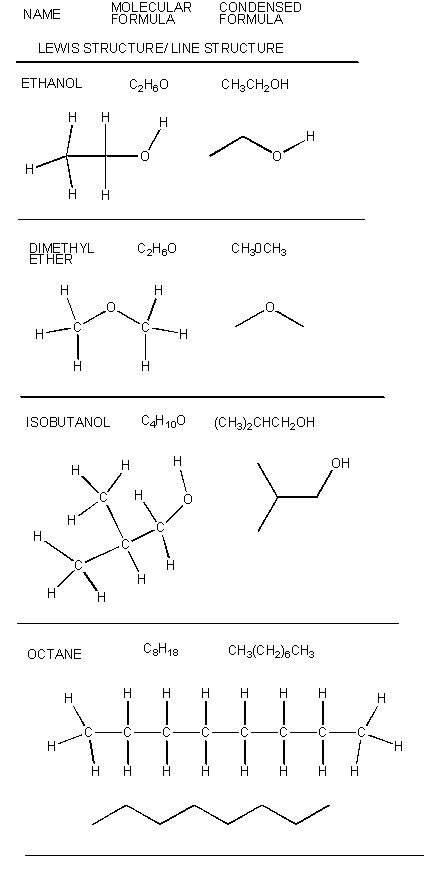
02/16/2007
Organic Structures
Organic chemistry centers on the chemistry of carbon-containing molecules, which include almost all the molecules within a biological organism. In this chapter, we will review the chemical and physical properties of basic organic molecules, some of which we have already studied.
Structures
Carbon forms 4 bonds to other atoms. Since it is not very large, it can get close to other atoms and form reasonably strong bonds. It can form nonpolar covalent bonds to other C's and H's, to form very long chains. It can also form polar covalent bonds with O and N, which are common in biological molecules. Molecules can be represented in many different ways which contains different amounts of structural information, including
Examples are shown below.

Classes
There are millions of different type of organic molecules. Some, composed of just hydrogen and carbon, are called hydrocarbons. Most biologically relevant organic molecules contain other atoms, including O, N, P, S, etc. We have already discussed sugars like glucose, which has the structure C6(H2O)6 - a carbohydrate. Among the hydrocarbons, we will discuss only the simplest - alkanes, which contain C-C single bonds, and alkenes, which have one or more C-C double bonds. Alkanes have the general molecular formula, CnH2n+2, while alkenes with one double bond have the general molecular formula CnH2n. Alkanes and alkenes can contain straight or branched chains of carbon atoms.
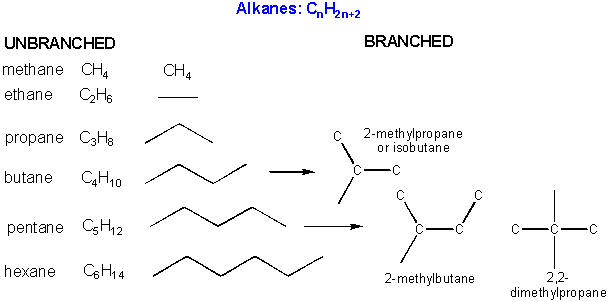
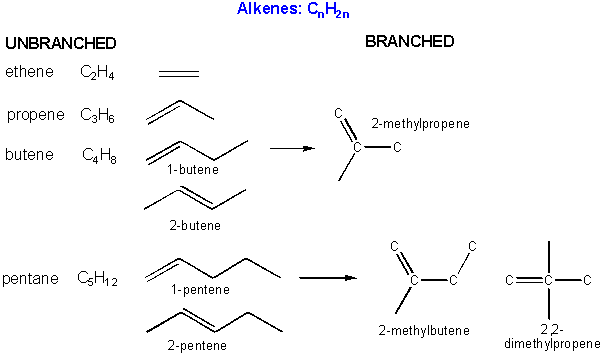
Hydrocarbons can also contain carbon chains which connect to each other to form a ring structure, called cycloalkanes or cycloalkenes.

Most organic molecules contain other atoms like O and N, which substitute for a H or C. New chemical functional groups can be created. For example, CH3OH contains a functional group called an alcohol, abbreviated as ROH, where R is a CH3- which is named methyl. Different R groups are shown below:
We will consider an R- group to consist of a group of atoms that end in a C atom which is directly bonded to the adjacent atom shown in the given structure.
Some carbon chains are linear, some are branched. Carbon atoms in organic molecule can have 1, 2, or 3 carbons attached to them. These are called primary, secondary, and tertiary carbons.
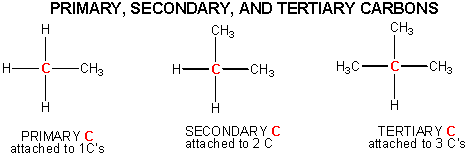
Common names are often used for the alkyl part functional groups as shown below.
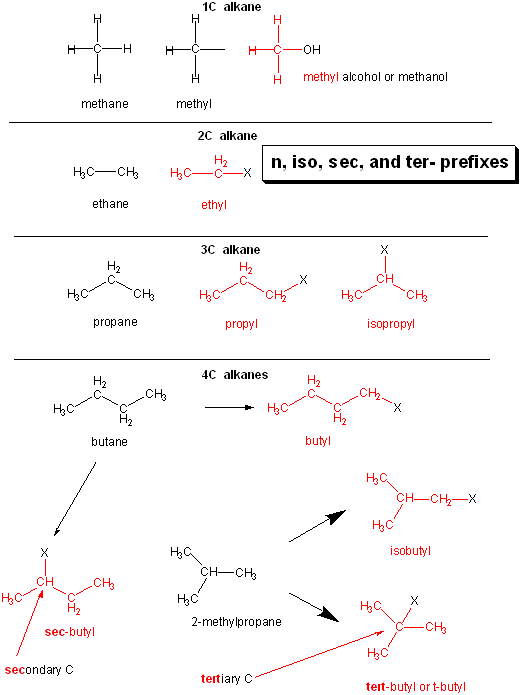
Isomers
Organic molecules can have the same molecular formula but different structural formulas - i.e. the atoms are connected in different ways. Hence these molecules are not identical - they are different. They are called structural or constitutional isomers . Examples are shown below.
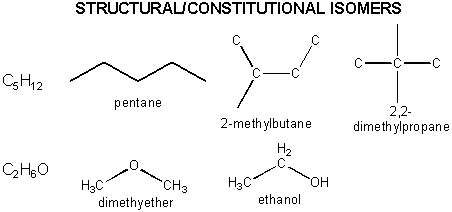
In addition, there are some organic molecules with the same molecular formula and same Lewis structure (hence they have the same connections between atoms in the molecues), but they differ from each other in the 3D - orientation of their atoms in space. They cannot be converted to each other by rotation around single bonds. These are called configurational isomers . Two major examples are shown below.
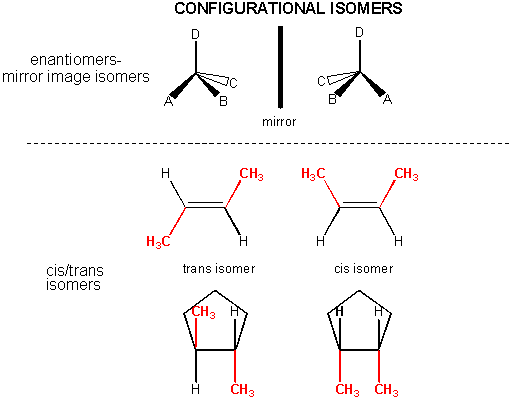
Breaking Bonds to Carbon
Now its is time to turn to the chemistry of organic moelcules. For hydrocarbons and carbohydrates to react, bonds to carbon atoms must be broken. As we have discussed previously, there are 3 ways to cleave a bond, leading to the formation of unstable, high energy, reactive carbanions, free radicals, and carbocations.

Carbanions are unstable (even though the carbon has an octet) since the negative charge is on a non-electronegative atom. Free radicals and carbocations are both electron deficient - neither have an octet.
Organic Functional Groups
Many organic molecules have O and N molecules, in addition to C and H. We can categorize these into a few simples classes:

Quiz: Carbonyl Group
Two important sets of reactions - 1: redox reactions
Redox reactions of biological organic molecules are extremely important. For example, we can take glucose and oxidize it to form CO2 and H2O. This can be done in a combustion reaction with the release of much energy or in the lab (or body) in a series of sequential steps in which the carbon atoms are successively oxidized using specific oxidizing agents. We discussed this in the last chapter on Chemical Reactions (see above figure)
In the lab, primary alcohols can be oxidized to aldehydes and carboxylic acids, while secondary ones can be oxidized to ketones by oxidizing agents like CrO3. In cells, ethanol is oxidized by a biological oxidizing agent, NAD+ (nicotinamide adenine dinucleotide), which along with ethanol binds to the active site of the enzyme, alcohol dehydrogenase. The mechanisms for these reactions are shown below. They are complicated, but you should be able to clearly see that the alcohol has been oxidized as it is converted to product. That is the take-home message from these figures.


Two important sets of reactions - 2: carbonyl chemistry
The carbonyl group, C=O, is found in many of the functional groups. Since the C is slightly positive, it is the site of attack for negatively charged groups like OH- and slightly negative groups oxygens such as in H2O. The chemistry of the functional groups with a carbonyl depend on which other groups are attached to the C. If only R groups and Hs are attached, the negative or slighty negative group that attacks the carbonyl C adds to the C. This occurs since R and H groups attached directly to the carbonyl C are poor leaving groups. They are unstable in aqueous solution since the negative on each leaving group is on atoms of low electronegativity (C and H respectively). Hence they are high in energy, very reactive and unstable, and not likely to be formed in aqueous solution. In contrasts, carboxylic acid derivatives like anhydrides, esters, and amides have an electronegative O or N directly attached to the carbonyl C. Hence when the negative or slightly negative O on the attaching molecule forms a bond to the carbonyl C, the group attached to the carbonyl C with an O or N can leave, since the negative charge on the departing leaving group will be on the electronegative O and N. Hence the negative or slightly negative O on the attaching molecule substitutes for the departed leaving group.


Many of the organic functional groups are found in biological molecules like proteins. These include:
The illustration below shows how the carboxylic acids and amines on a protein act as weak acids and bases, respectively, to form charged species, contributing to the overall charge distribution on the protein. In addition, it shows how an alcohol on a protein can react with a molecule called adenosine tripphosphate (ATP) which covalently transfers a phosphate group to the protein. The ATP is similar in structure to the carboxylic acid derivative, the anhydride. As water can cleave an anhydride (in a reaction called a hydrolysis), so can the slight negative on the O of the protein alcohol (ROH) attach the very slightly positive P in ATP as shown, resulting in a substitution reaction and the departure of ADP as the leaving group.